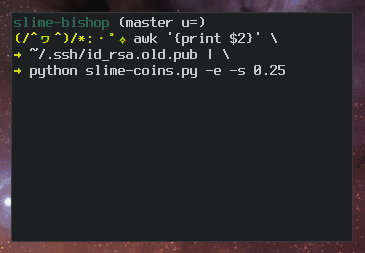Humans do no operate on hexadecimal symbols effectively […] there are exceptions.
– Dan Kaminsky
When SSH added ASCII art fingerprints (AKA, randomart), the author credited a talk by Dan Kaminsky.
As a refresher, randomart looks like this:
$ ssh-keygen -lv -f ~/.ssh/id_ed25519.pub
256 SHA256:XrvNnhQuG1ObprgdtPiqIGXUAsHT71SKh9/WAcAKoS0 thcipriani@foo.bar (ED25519)
+--[ED25519 256]--+
| .++ ... |
| o+.... o |
|E .oo=.o . |
| . .+.= . |
| o= .S.o.o |
| o o.o+.= + |
| . . .o B * |
| . . + & . |
| ..+o*.= |
+----[SHA256]-----+Ben Cox describes the algorithm for generating random art on his blog. Here’s a slo-mo version of the algorithm in action:

But in Dan’s talk, he never mentions anything about ASCII art.
Instead, his talk was about exploiting our brain’s hardware acceleration to make it easier for us to recognize SSH fingerprints.
The talk is worth watching, but I’ll attempt a summary.
What’s the problem?
We’ll never memorize
SHA256:XrvNnhQuG1ObprgdtPiqIGXUAsHT71SKh9/WAcAKoS0—hexadecimal
and base64 were built to encode large amounts of information rather than
be easy to remember.
But that’s ok for SSH keys because there are different kinds of memory:
- Rejection: I’ve never seen that before!
- Recognition: I know it’s that one—not the other one.
- Recollection: rote recall, like a phone number or address.
For SSH you’ll use recognition—do you recognize this key? Of course, SSH keys are still a problem because our working memory is too small to recognize such long strings of letters and numbers.
Hacks abound to shore up our paltry working memory—what Dan called “brain hardware acceleration.”
Randomart attempts to tap into our hardware acceleration for pattern recognition—the visiuo-spacial sketchpad, where we store pictures.
Dan’s idea tapped into a different aspect of hardware acceleration, one often cited by memory competition champions: chunking.
Memory chunking and sha256
The web service what3words maps every three cubic meters (3m²) on Earth to three words.
The White House’s Oval Office is ///curve.empty.buzz.
Three words encode the same information as latitude and
longitude—38.89, -77.03—chunking the
information to be small enough to fit in our working memory.
The mapping of locations to words uses a list of 40 thousand common English words, so each word encodes 15.29 bits of information—45.9 bits of information, identifying 64 trillion unique places.
Meanwhile sha256 is 256 bits of information: ~116 quindecillion unique combinations.
64000000000000 # 64 trillion (what3words)
115792089237316195423570985008687907853269984665640564039457584007913129639936 # 116 (ish) quindecillion (sha256)For SHA256, we need more than three words or a dictionary larger than 40,000 words.
Dan’s insight was we can identify SSH fingerprints using pairs of human names—couples.
The math works like this1:
- 131,072 first names: 17 bits per name (×2)
- 524,288 last names: 19 bits per name
- 2,048 cities: 11 bits per city
- 17+17+19+11 = 64 bits
With 64 bits per couple, you could uniquely identify 116 quindecillion items with four couples.
Turning this:
$ ssh foo.bar
The authenticity of host 'foo.bar' can't be established.
ED25519 key fingerprint is SHA256:XrvNnhQuG1ObprgdtPiqIGXUAsHT71SKh9/WAcAKoS0.
Are you sure you want to continue connecting
(yes/no/[fingerprint])?Into this2:
$ ssh foo.bar
The authenticity of host 'foo.bar' can't be established.
SHA256:XrvNnhQuG1ObprgdtPiqIGXUAsHT71SKh9/WAcAKoS0
Key Data:
Svasse and Tainen Jesudasson from Fort Wayne, Indiana, United States
Illma and Sibeth Primack from Itārsi, Madhya Pradesh, India
Maarja and Nisim Balyeat from Mukilteo, Washington, United States
Hsu-Heng and Rasim Haozi from Manali, Tamil Nadu, India
Are you sure you want to continue connecting
(yes/no/[fingerprint])?With enough exposure, building recognition for these names and places should be possible—at least more possible than memorizing host keys.
I’ve modified this from the original talk, in 2006 we were using md5 fingerprints of 160-bits. Now we’re using 256-bit fingerprints, so we needed to encode even more information, but the idea still works.↩︎
A (very) rough code implementation is on my github.↩︎